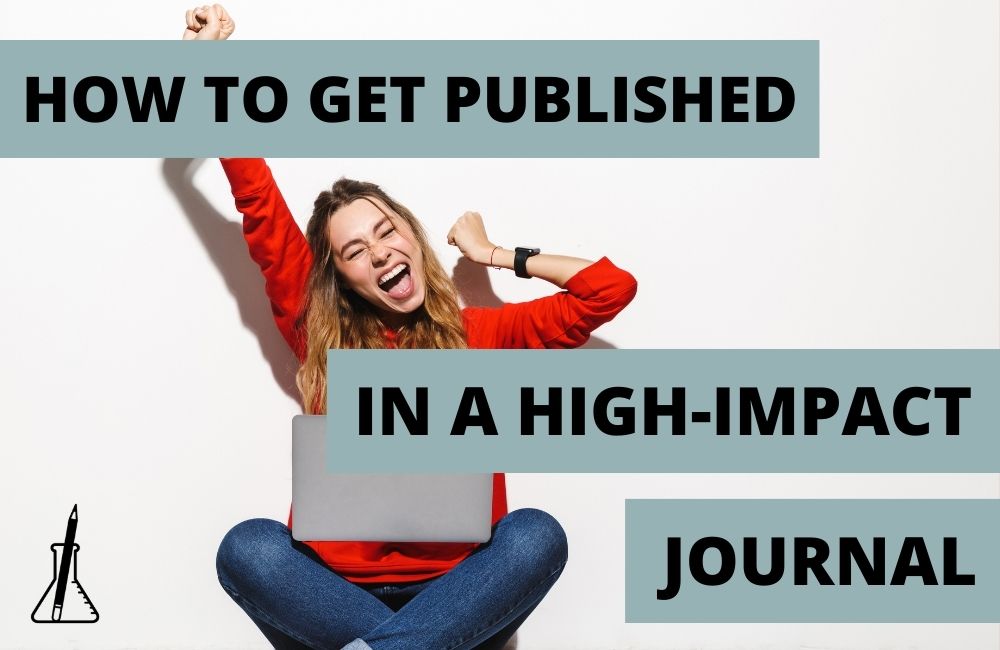Nature, Science, Cell, Advanced Materials… — publishing in high-impact journals is difficult but not impossible. Here what the impact factor means, what high impact research is and how to write high-impact research papers that get accepted in top-tier journals.
I don’t know what your goals are for this academic year, but one thing I’m pretty certain of: You wouldn’t have anything against publishing a paper or two in a high-impact journal. Am I right? 😉
Publishing in high-impact journals can open doors when you are climbing the academic career ladder: Prestigious grants, permanent positions, and opportunities for interesting collaboration often seem to follow publishing success. And of course, so does the recognition that the science you are doing is good.
That’s why early career scientists can’t overlook high impact scientific journals — even though the journal impact factor shouldn’t be the only parameter to look at when deciding on a journal for your high impact research. But what does “impact factor” mean?
Impact factor meaning
The journal impact factor measures the number of citations in the preceding two years relative to the number of published scientific articles during those years. That means that Nature, Science and other high-impact scientific journals mostly contain papers that get cited a lot and are – so goes the theory – more likely to make an actual impact in their research field and society as a whole.
I don’t need to tell you that publishing a scientific paper in a high-impact journal is hard. And with an increasing number of scientists publishing papers, it’s getting harder every year. The acceptance rate of a paper in Nature, for example, has dropped from about 11% between 1997 and 2001 to roughly 8% since 2010. Science reports that less than 7% of papers submitted to the journal are successful.
How to publish in high-impact journals
— 8 tangible tips
I don’t possess magic powers that guarantee that your papers will get accepted in high-impact scientific journals. I have, however, seven tips for you that can maximise your chances:
- Your study needs to solve a big and relevant problem
- Your research needs to be robust
- You need to tell a story
- You need figures that your reader can grasp quickly
- Your writing needs to be clear and concise
- Your abstract needs to tell a story too
- You need to follow the journal guidelines meticulously
- Your cover letter needs to convince
The first two points elaborate on what type of study high-impact scientific journals are looking to publish, and help you decide whether you have high-impact research on your hands or not. The following six points provide concrete instructions for how to write high-impact research papers.
High-impact research criteria
1. Your study needs to solve a big and relevant problem
The neatest figures, the punchiest narrative, and perfect English won’t help if your study isn’t of the kind that high-impact journals publish. These journals often contain research that the science sections in newspapers write or the science programs in radio channels or podcasts report about. Before you consider submitting your scientific paper, ask yourself whether you can picture a headline about your study in the New York Times or the Guardian (or the newspaper you are reading) – or in a magazine or online portal specialised in popularising scientific research.
More specifically, high-impact scientific journals look for studies that are (societally) relevant. High impact research solves a big problem and has serious implications — either for an application or something more fundamental.
You can perform a quick check by telling a relative, friend or neighbour who isn’t a scientist about your study. Do they immediately get what you are talking about and are they wowed? Possibly a candidate for high impact research then!

You prefer video to text? I recorded a whole class on how to publish in high-impact journals and you can get access for free right now.
If you want to get your hands on a template to write high-impact research papers in a systematic fashion, click the orange button below.
2. Your research needs to be robust
Even if you present an answer to a big problem, your research needs to be robust enough for Nature, Science or Cell to consider it. These high-impact scientific journals are generally looking for studies with findings that are corroborated using different relevant methods, or considering various conditions or model systems or whatever is applicable for your study. Meaning: the data sets of high impact research articles typically need to be quite comprehensive.
For example, if you see effect X, you should not only check with method A but also with method B. If you have invented a new method Y, you have to study whether it works on both model systems C and D, and for the relevant parameters E, F and G. This can mean that you will need to include results in one study that you would have split up into two or more articles for a more specialised scientific journal.
And last, but not least: Read the “Aim & Scope” section of your desired journal and cross-check the requirements outlined with what your study can deliver. This seems trivial but you can learn a lot!
How to write high-impact research papers
3. You need to tell a story
If you have followed me for a while, you might think I sound a little like a broken record. But the reason I keep banging on about storytelling is that it is so, so important. Some researchers think that they should use storytelling to “sell their research”. Selling often has a negative connotation and it seems to imply for many people that you are fooling the journal editor and reviewers by making your research sound better than it really is. First of all, that’s not what storytelling does, and secondly, selling isn’t always a bad thing (but let’s talk about this another time).
What you do when you tell a story in your paper is rather that you make it easy for your reader to understand what you are talking about. If you incorporate the element of a story such as the central message, problem, solution and implications in your article, your reader will understand your research more easily and probably find it more compelling. You’ve given them context and meaning, not just the facts. Want to know how to do it? Get my step-by-step scientific storytelling framework that we teach inside our online academic writing program, the Researchers’ Writing Academy. The best way to get started is by clicking this link to watch our free introductory training.
4. You NEED figures that your reader can grasp quickly
Your figures are the heart of your paper, they display your findings, the essence of your high impact research, and many readers (and journal editors!) are skipping right to the figures. The worst thing you can do here is to confuse your reader. Clutter, inconsistent colour coding, too much data, or the wrong plot type can turn your reader off and in some cases, distort the meaning of your data. If you want to learn more about creating amazing scientific figures, read about my step-by-step process to make figures for scientific papers here.
5. Your writing needs to be clear and concise
Often scientific authors confuse being a native speaker with knowing how to write. Let me tell you, these are two different pairs of shoes. Being a native speaker can help getting grammar and spelling right but effectively communicating your high impact research on paper requires the skill of writing. Therefore, don’t worry if you aren’t a native English speaker, you can still learn how to write well. (And don’t worry if English is your first language and you’re still struggling, we all start out there.)
Good academic writing is clear and concise. So, better put an end those long sentences and those paragraphs stretching over a whole page! We also want to avoid repetition (but don’t confuse this with using inconsistent terminology!). When editing your high impact research paper, I recommend analysing each sentence, each word even: Are they adding new information? You might be surprised by how many filler words you use that don’t add anything meaningful. I’ve listed some other tips to reduce word count in your scientific paper here.
6. Your abstract needs to tell a story too
Just listing a summary of your results in your abstract or summary paragraph isn’t enough if you want to publish in high-impact journals — especially if you are writing for a journal with a broad audience. Think about it: How much will your findings mean to a scientist from a different field or another discipline? Structuring your abstract in a way that it tells a story is something you can do for most high-impact scientific journals even if they have specific requirements for how the abstract should be structured. (By the way, inside the Researchers’ Writing Academy, you get your hands on my Abstract recipe that will get the abstract for your high-impact research paper written in minutes – if you have done your storytelling homework. 😉)
7. You need to follow the journal guidelines meticulously
If your study is great and ground-breaking, your story is in place, your figures are outstanding and your writing is clear, you can further increase your chances to get published in a high-impact journal by following the journal guidelines in absolutely every detail. For high-impact scientific journals in particular, the list can be long: Word count, reference format, section order, requirements for titles, headings and subheadings, … But it’s worth it! You’ll show the journal editor that you believe in your high-impact research and have made the effort. You are also making their lives easier (always a good thing).
8. Your cover letter needs to convince
The final crucial element to publishing in high-impact journals is your cover letter. You may feel like you’ve already said what you have to say in your scientific paper, but never ever just copy and paste text from your paper into your cover letter. The cover letter is your chance to speak to the journal editor directly. If you would like to understand what editors like to read in a cover letter, I recommend checking out this previous blog post. (And yes, you’ll of course get a cover letter template inside the Researchers’ Writing Academy as well.)
Publishing in high-impact journals – step by step
There you have it: How to publish in high-impact journals summarised in 8 tangible tips! By the way, these tips are also useful and relevant if you don’t want to shoot quite as high as Nature, Science, Cell or other high-impact scientific journals. More specialised journals aren’t going to be mad about a well-written and compelling paper!
If you have never published in a journal with a high impact factor, and find the whole process intimidating, I recommend to join our academic writing course, the Researchers’ Writing Academy. You’ll get your hands on the complete step-by-step process to write high-impact research articles. The best place to start is our free (no-strings-attached) intro training where I’ll share a birds-eye view of the system that has helped hundreds of researchers to publish in high-impact journals without lacking structure in the writing process. 👇👇







